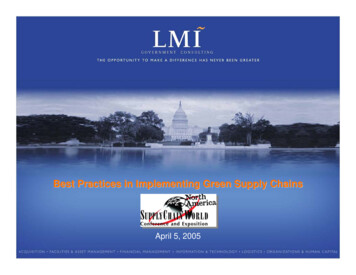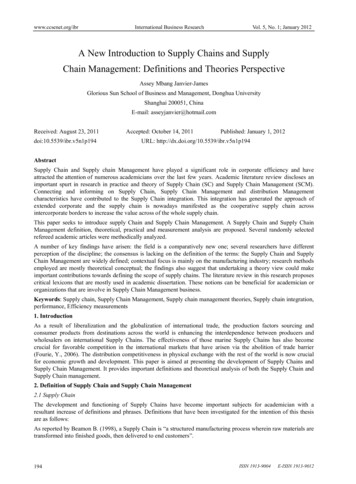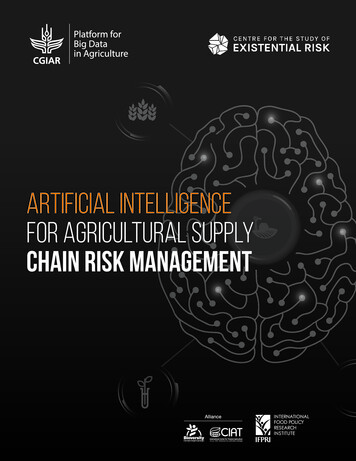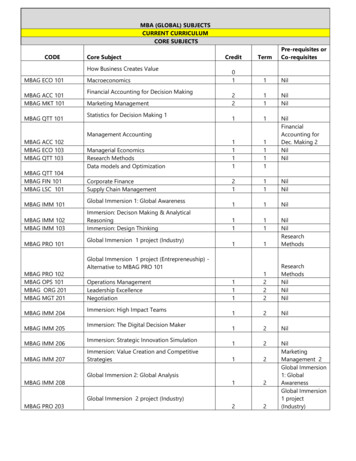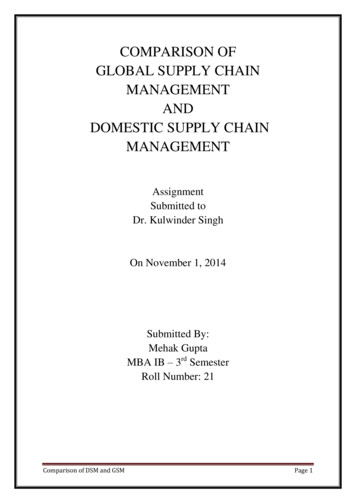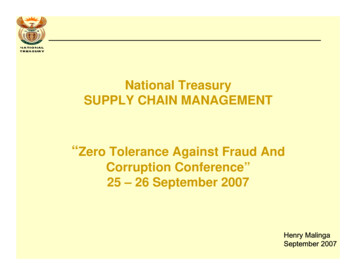
Transcription
National TreasurySUPPLY CHAIN MANAGEMENT“Zero Tolerance Against Fraud AndCorruption Conference”25 – 26 September 2007Henry MalingaSeptember 2007
Contents Background Legislative Environment SCM Process Acquisition Process PPPFA and BBBEE Alignment Prevention and Combating of Corruption Success Factors
BackgroundThe previous approach of acquiring goods and services in governmentwas highly prescriptive and had, amongst others, the followingdeficiencies: inconsistency in policy application,lack of accountability,lack of supportive structures,fragmented processes, etcSince 1995 Government has been involved in a number of initiatives toreform the procurement environment: Green paper on public procurement Roger Webb Procurement analysis CPAR (Country Procurement Assessment Report)-World BankTheThe aboveabove initiativesinitiatives resultedresulted inin thethe introductionintroduction ofof thethe INTEGRATEDINTEGRATED SUPPLYSUPPLY CHAINCHAINMANAGEMENTMANAGEMENT functionfunction inin government.government.
The following was approved by Cabinet A fifth pillar in respect of “equity” be included That the Minister of Finance issue general procurement guidelines,including the criteria of Black Economic Empowerment, capacitybuilding, training and job creation The National & Provincial Tender Boards and the various offices bephased out. A Common Service Provider on a cost recovery basis be established. That a pilot programme of procurement reform be implemented in fourNational departments. That the need for a White Paper on procurement reform is supercededby these decisions
Joint CPAR 2001A range of issues that required resolution was identified.Governance related issues–––––––Insufficient Planning and linking to budgetLack of uniform bid and other proceduresConflict of interest due to composition of Tender BodiesConsultants not selected in systematic competitive mannerFlaws (corruption) in award of tendersInsufficient training of staffProcurement Processes too rule drivenIssues with the Preferential Procurement Policy Framework Act (PPPFA) andits regulations.––––––––PPPF Policies not formulated well due to lack of National targetsCost and outcomes not adequately assessed to evaluate merits of systemIncorrect interpretation of Policy (set-asides)Not adequately evaluating who qualified as disadvantaged (verifying claims for preferencepoints)Does not cater for capacity building for disadvantaged enterprisesLack of quantitative data on cost and outcome of preferential systemNo provision for graduationConflicting policiesThe conclusions of the CPAR formed the basis for further work done incollaboration with provinces and other stakeholders.
LEGISLATIVE ENVIRONMENTTHAT SUPPORTEDPROCUREMENT REFORMIN GOVERNMENT
LEGISLATIVE ENVIRONMENTSection 217(I) of The Constitution provides the basis for procurementby determining that:“When an organ of state in the national, provincial or local sphere ofgovernment, or any other institution identified in national legislation,contracts for goods and services, it must do so in accordance with asystem which is fair, equitable, transparent, competitive and costeffective”.Section 217(I) of The Constitution further confers:an obligation for national legislation to prescribe a framework providing forpreferential procurement to address the social and economic imbalancesof the past.The Preferential Procurement Policy Framework Act (PPPFA) of 2000 andits accompanying Regulations were promulgated to achieve these goals.(This Act incorporated the 80/20 and 90/10 preference point systems.)
LEGISLATIVE ENVIRONMENTSection 215-219 of The Constitution further require that: The National Treasury introduce norms and standards within government toprescribe transparency and expenditure control measures, which should includebest practices to regulate financial management in the national and provincialspheres of government.The Municipal Finance Management Act (MFMA) has also been promulgated: Extend the same principles to municipalities
LEGISLATIVE ENVIRONMENT Thus, it is the responsibility of the National Treasury to: foster coherent financial management in all organs of State, across all spheres ofgovernment; at the same time, ensure that considerable powers are devolved to accounting officers to enable them tomanage their affairs within the parameters laid down by the prescribed norms andstandards. Section 76(4)(c) of the Public Finance Management Act (PFMA) providesthat : The National Treasury may issue a procurement framework for national and provincialdepartments; A similar provision is also contained in chapter 11 of the Municipal FinanceManagement Act (MFMA) that is applicable to municipalities.This framework is to ensure the optimal achievement of government’sbroader strategic objectives.
Major shifts from the Webb ReportEstablish parameters for the Supply Chain Management Office in theNational Treasury to:– Monitor adherence to minimum norms and standards as well as policyoutcomes.– Facilitate the arrangement of transversally used term contracts.
Supply Chain ManagementThe concept of an integrated supply chain management policy system wasproposed– Supply Chain Management could be described as a function thatensures that goods and services are delivered to the right place, inthe right quantity, with the right quality, at the right cost and at theright time.This process is aimed at :– Introducing international best practices as part of government’sdrive towards improved financial management.– Replacing the outdated procurement and provisioning processes.– Introducing uniformity in supply chain management policies andstandards in all spheres of government.
On 10 September 2003, Cabinet approved the adoption of a PolicyDocument, titled “Policy to Guide Uniformity in Procurement ReformProcesses in Government” This policy strategy is intended to guide the uniform implementation ofGovernment’s procurement reform initiatives and the issuing ofRegulations of the Framework for Supply Chain Management. The Minister of Finance approved the promulgation of the RegulatoryFramework for supply Chain Management on 05 December 2003. Accounting officers / authorities are required to establish and implementa supply chain management function that promotes sound financialmanagement and uniformity in all spheres of government.
SUPPLY CHAIN MANAGEMENTPROCESS
Supply Chain Management ProcessDisposalAcquisitionLogisticsSUPPLY CHAIN PERFORMANANCEDATABASE/SRISK MANAGEMENTGOVERNMENT’S PREFERENTIALPROCUREMENT POLICY OBJECTIVESINFRASTRUCTURE (SYSTEMS)Demand
ACQUISITION PROCESS
Acquisition ProcessSourcing StrategyThe Business Owner3Bid Specification4Evaluation5RecommendationsThe Bid Committee: Business Owner Technical Financial SCM Unit Legal6AdjudicationThe Adjudication Committee7ContractingThe SCM Unit12
Preferential Procurement Policy FrameworkAct (PPPFA)andBroad-Based Black EconomicEmpowerment Act(BBBEEA)
PPPFA and BBBEE Alignment Ambiguities between PPPFA and BBBEEA were identified thus theneed for the alignment of the two legislations. Some of these ambiguities were– inconsistency in the policy application– The definition of HDI was too broad leading to huge fronting– BBBEE and PPPFA were out of sync Cabinet instructed that the two legislations be aligned
PPPFA and BBBEE Alignment cont. A work group was established between National Treasury and the BEEunit of the Department of Trade and Industry to deal with the alignment Draft amendment of the Preferential Procurement Policy FrameworkAct is currently with the state law advisors for legal refinement. The legislative process shall start soon.
Prevention and Combating of Corruption
Prevention and Combating of CorruptionCombat abuse of SCM system Accounting officers should take all reasonable steps to prevent abuse ofthe scm system.Accounting officers must reject a bid from any bidder who:has abused the scm system or who hascommittedanyimproper conduct;has been convicted for fraud or corruption during the pastfive (5) years;has willfully neglected or failed to complywith any publicsector contract during the past five(5)years;has been listed in the Register for TenderDefaulters in termsof section 29 of thePrevention andCorruptActivitiesAct (No 12 of 2004).
Prevention and Combating of CorruptionCombat abuse of SCM system (cont.) Accounting officers must cancel a contract awarded to aperson if:the person committed any corrupt or any fraudulentact during the bidding processor execution of thecontract;an official or other role player committed any corruptor fraudulent act during thebidding process orexecution of the contract that benefited that person.
Prevention and Combating of CorruptionREGISTER FOR TENDER DEFAULTERSPrevention and Combating of Corrupt Activities Act, Act No. 12 of 2004Background Section 29 of the Act provides for the Establishment,Maintenance and Management of a Register for TenderDefaulters.Register to contain particulars of persons or enterprisesconvicted by a court for corrupt activities relating to tenders,contracts and procurement (sections 12 and 13)
Prevention and Combating of CorruptionNational Treasury’s Role in the Implementation of the Act Minister of Finance approved that the Registrar should be fromthe National Treasury.On 9 March 2005, a Registrar was appointed.The Regulations Regarding the Register for Tender Defaulterswas approved for promulgation by the Minister of Finance inconsultation with Justice. Promulgated on 11 March 2005 inGovernment Gazette 27365.Department of Justice to furnish the National Treasury withdetails of all convictions relating to sections 12 and 13 of the Act.A copy of the Register has been placed and will be maintainedon the web-page of National Treasury. www.treasury.gov.zaAccounting Officers need to put in place a mechanism to dealwith grievances relating to the SCM process.National Treasury is currently looking at establishing a NationalCompliance monitoring unit to deal with deviations from SCM
Prevention and Combating of CorruptionDatabase of Restricted Persons Treasury Regulation 16.A9 (c) prescribes that prior to awarding anycontract the National Treasury’s database of persons prohibited fromdoing business must be checked.This database contains details of persons restricted from doing businesswith government for having obtained preference fraudulently or havefailed to attain specified goals during the performance of the contract.These restrictions have been imposed by the former tender boards oraccounting officers and not by a court of law. The database is thereforenot accessible to the public.Supply Chain Management Practice Note Number 5 of 2006 issued on09 October 2006 empowers accounting officers to restrict suppliers fromdoing business with government.The General Conditions of Contract has been augmented accordingly togive effect to these powers.
SUCCESS FACTORS
Success Factors Supply Chain has found its rightful place in government SCM has been implemented in all spheres of government Strategic Sourcing
EVERY ATTEMPT SHOULD BE MADE TO DEAL WITHTHE AQUIRING OF GOODS AND SERVICES IN THESPIRIT OF SECTION 217 OF THE CONSTITUTION OFTHE REPUBLIC OF SOUTH AFRICATHANK YOUFor further details:National Treasury SupplyChain Management Policy(012) 315 5502
Supply Chain Management Process (Demand)Demand Management Understanding future needs Identifying critical delivery dates The frequency of need Linking the requirement to the budget Doing an expenditure analysis Determining the specifications Doing a commodity analysis Doing an industry analysisBACK
Supply Chain Management Process (Logistics)BACKLogistics Management For stock or inventory items the following functions will amongst others be performed: Coding of items Setting of inventory levels Placing of orders Receiving and distribution of material Stores/Warehouse management Expediting management Transport management; and Vendor performance, etc For fixed capital items (construction and road projects, immovable property) a similarprocess, mutates mutandis has to be adopted, I.e. appropriate classification, additions toasset and property register, valuation, main use, etc. From this process the financialsystem is activated to generate payments.
Supply Chain Management Process (Disposal)Disposal Management At this stage: Obsolescence planning or depreciation rates per item required to be calculated; A data base of all redundant material is kept; Material inspected for all potential re-use; A strategy is determined of how the items are going to be disposed of; and Executing the physical disposal process Again a similar set of procedures is applicable to fixed capital stock, I.e. depreciation,maintenance and replacement planning and costing, etc.BACK
Supply Chain Management Process (Acquisition)Acquisition Management Preferential procurement policy objectives are identified that could be met throughthe specific contract The strategy of how the market is to be approached is determined Applicable depreciation rates are determined The total cost of ownership (TCO) principle isbeing applied e.g. - Life cycle cost- Inventory carrying cost The bid document would be compiled, attaching all necessary required documentsand giving conditions etc The bid evaluation evaluation criteria is determined Bids would be evaluated and recommendations tabled Contract documents would be compiled and signed Contract administration is done; and Contract information is used to kick-start the logistics ,managementprocessBACK
1. Sourcing Strategy – Establishing the need for Bid andBACKAdjudication Committees What needs to be sourced and why (the businesscase)?What will the impact be on the internal andexternal environment?Who are the stakeholders and how will theyrespond?What are the affordability levels?Are there any legal issues?What are the sourcing issues and options?What are market place characteristics?Evaluate and select the most appropriate sourcingstrategy.Confirm the need for and composition of Bid &Adjudication Committees.1345267
2. Begin with the end in mind - Consultation with theAdjudication AuthorityA process of consultation with the AccountingOfficer (also the adjudication authority)To review and confirm the Sourcing Strategy.To review and confirm the structure andcomposition of the Bid and AdjudicationCommittees.Identify and confirm specific individuals to beappointed.Confirm and arrange availability.Finalise the bidding process in terms of process,procedures, policies, roles and responsibilities andtime line.Finalise, authorise and authenticate the SourcingStrategy.BACK1345267
3. Bid Specifications – The primary responsibility of theBACKBid CommitteeWith the authorised Sourcing Strategy as primaryinput.With input from and participation of the BidCommittee members or thereassistants/representatives.Co-opted capacity and skills depending on thenature and extent of the work required.Establish and finalise evaluation criteria.Consider RDP, BEE, SMME, local/regional, IDP orother development goals.Consider technical standards (SABS, ISO andother industry/commodity specific standards).Consider legal and commercial issues,requirements and terms and conditions.Produce, authorise and publish the BidSpecifications1345267
4. Evaluation – By the Bid Committee against the agreedBACKBid SpecificationReceive competitive bid documentation.Establish an effective and secure workingenvironment.Establish confidentiality agreements, policies andprocedures.Establish appropriate communication protocols.Finalise the evaluation approach and procedureconsistent with the approved evaluation criteria.Evaluate and score competitive bids.Request clarification from bidders throughappropriate communications.Develop findings and conclusions based on theevaluation results.1345267
5. Recommendation – By the Bid Committee for theAdjudication CommitteeDevelop a full report for consideration by theAdjudication Committee.Include full details of the process followed by theBid Committee.Summarise evaluation results, findings andconclusions.Recommend a preferred bidder and a fulljustification.Highlight issues for consideration and resolutionduring negotiation and contracting stages.Confirm the business case, affordability levels andrisk profile.Confirm the impact on the internal and externalenvironment and all the stakeholders.BACK1345267
6. Adjudication – the Accounting Authority supported byBACKthe Adjudication CommitteeThe report and recommendations of the BidCommittee can now be reviewed and consideredby the Accounting Authority supported by theAdjudication Committee.The Accounting Authority should now be in aposition to approve, reject or override therecommendations of the Bid Committee.Full clarification should be documented for auditingpurposes should the Accounting Authority and/orAdjudication Committee decide to reject oroverride the Bid Committee.Independent specialists may be co-opted to assistthe Accounting Authority and/or AdjudicationCommittee.The final decision can now be communicated andpublished, and instructions given to the SCM Unitto conclude contract negotiations and closure.1345267
7.Contracting – The final step in the bidding process. The final step in the process. The responsibility of the SCM Unit. May require the assistance of the Bidand Adjudication Committees to ensurethat the recommendations and finaldecisions are contractually implementedconsistent with the original SourcingStrategy and Bid Specification.BACK1345267
Supply Chain Management The concept of an integrated supply chain management policy system was proposed - Supply Chain Management could be described as a function that ensures that goods and services are delivered to the right place, in the right quantity, with the right quality, at the right cost and at the right time. This process is aimed at :




